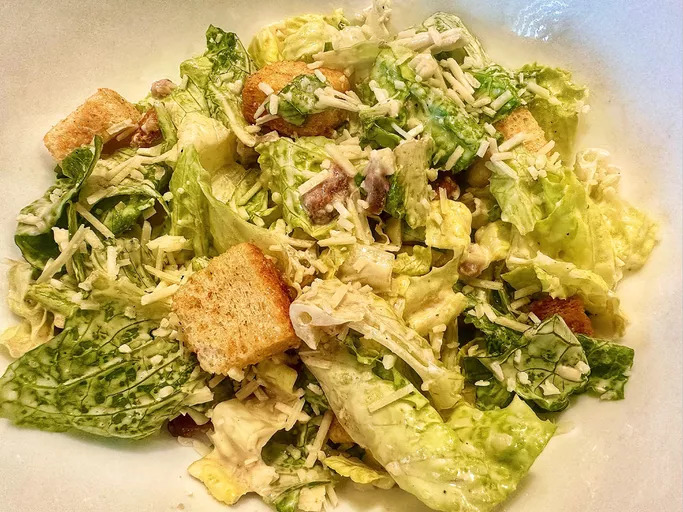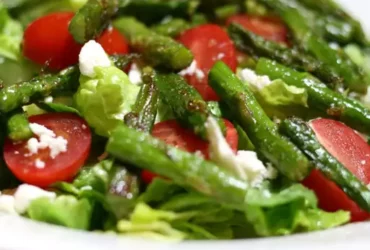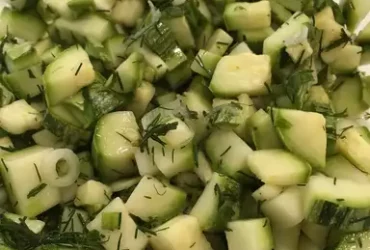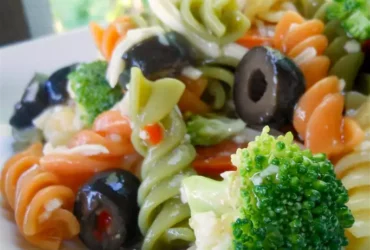Ingredients
For the croutons
- When it comes to making classic Caesar salad, one of the most essential ingredients are the croutons.
- The croutons are typically made from cubed bread that has been toasted or fried until crispy and golden brown, adding a satisfying crunch to the dish.
To make homemade croutons, you will need the following ingredients:
- 1/2 cup (60g) of stale white bread, preferably day-old bread, cut into 1-inch (2.5 cm) cubes
- 2 tablespoons (30g) of olive oil
- 1 teaspoon of salt
- Optional: garlic powder or dried herbs such as thyme, rosemary, or oregano for added flavor
- The type of bread you choose will greatly impact the taste and texture of your croutons. For a classic Caesar salad, it’s best to use a neutral-tasting white bread that won’t compete with the other flavors in the dish.
Some popular options include:
- Baguette: This is a classic choice for croutons and will give you a crispy exterior and a soft interior.
- Ciabatta: Similar to baguette, ciabatta has a light texture and a slightly sweet flavor that pairs well with the savory flavors of the Caesar salad.
- Focaccia: For a more rustic crouton, try using focaccia bread. It will have a chewier texture and a more robust flavor.
- Remember to always use stale bread for croutons, as it will be easier to toast or fry without becoming too greasy or soggy.
1 cup stale bread, cut into 1/2inch cubes
The star ingredient that sets this salad apart from its store-bought counterparts is the homemade croutons, and at their core, they’re made from stale bread. Specifically, you’ll need one cup of stale bread, which should be cut into 1/2-inch cubes.
This humble ingredient might seem ordinary, but it’s the perfect base for creating crispy, golden-brown croutons that add texture and flavor to the salad. The key to making great croutons is using high-quality bread that’s not too fresh or too stale – you want it to be just right.
The type of bread you choose can also affect the final result. A crusty baguette or ciabatta works beautifully, while a soft white bread might not hold up as well. You can even use leftover bread from last night’s dinner or a day-old loaf from the bakery.
Once you’ve got your bread cubed, you’re ready to move on to the next step in making these addictive croutons: tossing them with olive oil and seasonings. But that’s where we’ll pause for now – let’s focus on the bread and how it sets the stage for the rest of the salad.
In terms of the specific characteristics you’re looking for in your stale bread, aim for something that’s dense but not hard as a rock. You want to be able to cut through it easily with a knife or bite into it without it crumbling apart. If your bread is too fresh, it might fall apart when cubed, while if it’s too old, it could become discolored or develop an unpleasant texture.
Of course, the beauty of this recipe is that you can use whatever type of bread you have on hand – even if it’s not exactly perfect. The key is to experiment and find the combination that works best for you. So don’t be afraid to get creative and try different types of bread or seasonings to make your croutons truly one-of-a-kind.
2 tablespoons olive oil
Olive oil is an essential ingredient in many Mediterranean and Italian recipes, including the classic Caesar salad. It serves as a base for dressing and adds a distinct flavor to various dishes. Two tablespoons of olive oil are used in this recipe to make the homemade croutons crispy and flavorful.
In order to appreciate the significance of olive oil in cooking, it’s necessary to understand its characteristics and uses. Olive oil is extracted from olives, which are harvested from olive trees during specific times of the year. The extraction process involves crushing or pressing the olives to release their oil content. This natural process yields a rich, flavorful oil that’s ideal for dressings, marinades, sautés, and more.
Olive oil has a distinct flavor profile that is often described as fruity, peppery, or grassy, depending on the type of olive used and the production methods employed. In this recipe, the 2 tablespoons of olive oil add a subtle yet nuanced taste to the homemade croutons, complementing the savory flavors of the herbs and cheese.
When choosing an olive oil for cooking, it’s essential to select a high-quality oil that complements the other ingredients in your dish. For this recipe, a mild or medium-intensity olive oil is suitable, as it won’t overpower the delicate flavors of the croutons and other salad components.
The two tablespoons of olive oil also play a crucial role in achieving the perfect texture for the homemade croutons. By brushing the bread with olive oil before baking, you create a crispy exterior and a fluffy interior, which is essential for the crunchy texture that defines this classic Caesar salad recipe.
Salt, to taste
The phrase “to taste” often appears in recipes as a directive for salt or other seasonings. In this case, the instruction to use “salt, to taste” refers specifically to adding salt to enhance the flavor of the homemade croutons in our Classic Caesar Salad with Homemade Croutons recipe.
When using “to taste” in this context, it is essential to understand that the amount of salt added will vary depending on individual preferences and the specific needs of each dish. In essence, adding salt to taste means adjusting the seasoning until the desired level of flavor is achieved. The goal is not to add a fixed or specific amount but rather to season judiciously based on personal preference.
For our Classic Caesar Salad with Homemade Croutons, the use of salt to taste is particularly crucial because it directly affects the overall balance and depth of flavors in the dish. When making homemade croutons, a small pinch of fine sea salt can go a long way, but using salt to taste also depends on personal preference and regional differences in saltiness.
It’s worth noting that while “to taste” is subjective and relies on individual discretion, it typically implies the need for fine-tuning. This means adjusting seasoning after tasting, adding just enough to elevate flavors without overpowering them. In contrast to an absolute measurement or a specific quantity of salt to add, “to taste” leaves room for creativity and allows chefs and home cooks to develop their own signature flavor profiles.
When interpreting the instruction to use “salt, to taste,” it is crucial to consider the overall composition of your salad. For our Classic Caesar Salad with Homemade Croutons recipe, we aim to achieve a harmonious balance between crunchy croutons, fresh greens, and savory dressing. Salt, therefore, should be used thoughtfully, not as an afterthought but rather as an essential component that elevates each bite.
Given the subjective nature of seasoning with salt, it’s also important to remember that taste is a highly personal experience influenced by various factors such as individual preferences, cultural background, and even environmental conditions. As a result, what might be considered “to taste” for one person could vary significantly from another person.
To accurately season your salad using the phrase “salt, to taste,” it’s helpful to consider this dynamic when adding salt to your homemade croutons. Begin with a small amount and adjust accordingly based on the feedback you get from tasting your creation. This ensures that each bite of your Classic Caesar Salad with Homemade Croutons has the perfect balance of flavors.
In conclusion, “salt, to taste” is an instruction that highlights the subjective nature of seasoning, leaving room for personal preference and creativity in the kitchen. For our Classic Caesar Salad with Homemade Croutons recipe, this directive underscores the importance of using salt judiciously, not as a fixed quantity but rather as a means to enhance flavors and achieve harmony.
For the salad
The Classic Caesar Salad is a timeless and iconic dish that originated in the 1920s at a restaurant in Tijuana, Mexico. The salad’s main ingredients are simple yet harmonious, making it a staple in many restaurants around the world.
For the salad, you will need the following key ingredients:
- Crisp romaine lettuce: This is the base of the salad and should be fresh and of high quality. You can use either loose-leaf or head lettuce, but make sure it’s crisp and not wilted.
- Parmesan cheese: A classic Italian cheese that adds a salty, nutty flavor to the salad. Grated Parmesan is essential for this recipe, as it allows the cheese to distribute evenly throughout the salad.
- Crispy garlic croutons: The crunchy texture of croutons is an integral part of the Classic Caesar Salad experience. You can make your own garlic croutons from scratch using bread, olive oil, and minced garlic.
- Anchovy fillets: These small fish are often a divisive ingredient, but they add a rich, savory flavor to the salad that complements the other ingredients beautifully. You can omit them if you’re not a fan, but it’s worth trying them at least once.
For the homemade croutons recipe, you will need:
- Bread: A day-old baguette or Italian bread works well for making garlic croutons. Simply slice the bread into small cubes and bake them in the oven until crispy.
- Extra virgin olive oil: This is the perfect oil to use when making garlic croutons, as it has a mild flavor that won’t overpower the other ingredients.
- Minced garlic: Fresh garlic is essential for adding depth and complexity to your homemade garlic croutons. Simply mince 2-3 cloves of garlic and mix it with olive oil before brushing it onto the bread cubes.
The beauty of this recipe lies in its simplicity, allowing each ingredient to shine while still coming together in harmony to create a truly unforgettable dining experience.
46 lettuce leaves (Romaine or similar variety)
- Romaine lettuce, also known as cos lettuce, is a popular variety used in many salads, including the classic Caesar salad.
- The reason for using Romaine lettuce is due to its slightly bitter taste and crunchy texture, which pairs well with the savory flavors of the croutons and dressing.
Why 46 Lettuce Leaves?
The exact number of lettuce leaves can be adjusted based on individual preferences and serving sizes. However, in this recipe, using 46 lettuce leaves provides a generous amount for each salad serving.
A good rule of thumb is to plan for about 2-3 lettuce leaves per serving, considering the other ingredients and portion control.
Tips for Selecting Lettuce Leaves
- Choose crisp and fresh Romaine lettuce with no signs of wilting or browning.
- Select heads with firm, compact hearts and uniform leaves.
- Avoid lettuce with visible damage, such as torn or yellowed leaves.
Preparing Lettuce Leaves
To prepare the lettuce leaves for the salad, rinse them under cold running water to remove any dirt or debris.
Gently pat the leaves dry with a clean kitchen towel to prevent excess moisture from affecting the dressing and croutons.
1 cup homemade croutons
In the preparation of a Classic Caesar Salad with Homemade Croutons, the ingredients play a crucial role in bringing out the authentic flavors and textures that this iconic salad has to offer.
For the croutons, we will be using bread as our primary ingredient, and it is essential to choose the right type. A rustic bread with a denser texture works best for making croutons, as it holds up well to being toasted and seasoned. Some popular options include Italian bread or Ciabatta.
The amount of bread required for 1 cup of homemade croutons is approximately one small baguette or three slices of rustic bread. The specific quantity may vary depending on the type of bread used, but a good starting point is to use about one-third of a baguette.
To ensure that our croutons have a crispy texture and a rich flavor, we will be using some essential seasonings. These include olive oil, salt, and freshly ground black pepper. The key here is to use high-quality ingredients, as the flavors they impart to the bread will ultimately determine the taste of the croutons.
Some other optional ingredients that can be used to enhance the flavor of our croutons include garlic powder, dried herbs like thyme or oregano, and grated Parmesan cheese. These add-ons are completely up to personal preference, but they do add an extra layer of depth and complexity to the overall taste experience.
It’s also worth noting that some people prefer their croutons a bit more substantial, so you can experiment with adding other ingredients like chopped nuts or seeds for added crunch. Just be sure not to overdo it, as too many add-ins can overpower the delicate flavors of the bread and seasonings.
For 1 cup of homemade croutons, we will need:
- 1 small baguette or 3 slices of rustic bread
- 2 tablespoons olive oil
- Salt, to taste
- Freshly ground black pepper, to taste
- Optional: garlic powder, dried herbs like thyme or oregano, and grated Parmesan cheese
1 cup shaved Parmesan cheese
The classic ingredients for a delicious Caesar salad include:
For the croutons
- 1 cup (250g) day-old bread, preferably Italian or French, cut into 1-inch (2.5 cm) cubes
- 4 tablespoons (55g) olive oil
- 1 teaspoon garlic powder
- Salt and black pepper to taste
- 2-3 tablespoons chopped fresh parsley, optional
For the dressing
- 2 cloves garlic, peeled and minced
- 1 egg yolk
- 2 teaspoons (10g) Dijon mustard
- 2 tablespoons (30g) freshly squeezed lemon juice
- 1/4 teaspoon black pepper
- 1 cup (120ml) extra virgin olive oil
- 1/2 cup (60g) grated Parmesan cheese, preferably fresh and of good quality
- 1/4 teaspoon salt
For the salad
- 6-8 lettuce leaves (iceberg or romaine)
- 1 cup shaved Parmesan cheese (250g), preferably fresh and of good quality
- Classic Caesar croutons, as made above
Note: You can use store-bought croutons if you prefer. However, making your own croutons adds a delicious homemade touch to the salad.
1/4 cup chopped fresh parsley
- Parsley is one of the most versatile and aromatic herbs used in many classic dishes, including the renowned Classic Caesar Salad with Homemade Croutons.
- The primary role of parsley in this recipe is to provide a fresh, bright flavor that complements the savory elements of the salad.
- Chopped fresh parsley is typically added at the end of the preparation process to preserve its delicate aroma and taste.
- To incorporate parsley into your Classic Caesar Salad with Homemade Croutons, start by rinsing a bunch of fresh parsley under cold running water.
- Gently shake off excess water from the leaves and pat them dry with a clean kitchen towel or paper towels to prevent moisture from affecting the flavor and texture of the herb.
- Next, snip the parsley into small, even pieces using a sharp knife or kitchen scissors.
- The amount required for this recipe is 1/4 cup chopped fresh parsley, which should yield around 2-3 tablespoons of finely cut leaves.
- This moderate quantity ensures that the flavor of the herb is adequately represented without overpowering the other ingredients in the salad.
Instructions
Making the Croutons
To make the croutons for our Classic Caesar Salad, we need to start by preheating our oven to 350°F (180°C). This will ensure that our croutons turn out crispy and golden brown.
Next, we’ll need to prepare our bread. For this recipe, you can use any type of bread you like, but classic Caesar salads typically call for a crusty Italian or French bread. Cut the bread into small cubes, about 1/2 inch (1 cm) in size.
Now, let’s move on to seasoning our croutons. In a large bowl, combine:
- 3 tablespoons of olive oil
- 1 teaspoon of garlic powder
- 1 teaspoon of salt
- 1/2 teaspoon of black pepper
Mix these ingredients together until well combined. Then, add the bread cubes to the bowl and toss them until they’re evenly coated with the seasoning mixture.
Spread the bread cubes out in a single layer on a baking sheet lined with parchment paper. You may need to do this in batches depending on the size of your baking sheet.
Bake the croutons in the preheated oven for 10-15 minutes, or until they’re golden brown and crispy. Stir them halfway through the cooking time to ensure even browning.
Once the croutons are done, remove them from the oven and let them cool completely on the baking sheet. They’ll crisp up even more as they cool.
Now that our croutons are ready, we can move on to assembling our Classic Caesar Salad. But first, let’s review what we’ve accomplished so far:
- We preheated the oven to 350°F (180°C).
- We prepared our bread by cutting it into small cubes.
- We seasoned our croutons with olive oil, garlic powder, salt, and black pepper.
- We baked the croutons in the oven until they were golden brown and crispy.
Preheat oven to 350°F.
The first step in preparing a Classic Caesar Salad with Homemade Croutons is to preheat the oven to the correct temperature, which is 350°F. This is crucial as it ensures that the croutons bake evenly and at the right pace.
To achieve this, locate your oven’s control panel and turn the dial or press the button until the desired temperature is reached. For most ovens, you will need to enter the number 350 using the keypad or select it from the pre-programmed options.
Once you’ve set the oven to the correct temperature, it’s essential to wait for it to reach that point. This can take a few minutes, depending on your oven’s heating time. You will know when it has reached 350°F because the display screen or indicator light will show the exact temperature.
While waiting for the oven to heat up, you can prepare the other ingredients for the Classic Caesar Salad with Homemade Croutons Recipe. This includes chopping lettuce, preparing croutons from bread, making a homemade Caesar dressing, and assembling the salad.
Once the oven is at 350°F, place the crouton strips on a baking sheet lined with parchment paper or aluminum foil, leaving some space between each strip for even baking. Drizzle them with olive oil and sprinkle with seasonings as desired, then proceed to bake until golden brown.
Baking the croutons in this manner will result in crispy and flavorful pieces that add texture and taste to your Classic Caesar Salad. By following these steps carefully, you can create a delicious homemade version of this classic salad without sacrificing any flavor or quality.
Toss bread cubes with olive oil and salt until evenly coated.
Instructions are a crucial element in cooking, as they provide a clear and concise guide for preparing and executing recipes. In the case of making homemade croutons for a classic Caesar salad, instructions play a vital role in ensuring that the final product turns out delicious and visually appealing.
One of the key benefits of following detailed instructions is that it helps to minimize errors and ensures consistency in the cooking process. When preparing croutons, for example, the instructions may specify the exact amount of bread cubes to use, the type of oil to use for tossing, and the seasoning to add. By following these instructions carefully, cooks can reproduce the same results each time they make the recipe.
Instructions also provide a sense of confidence and security in the cooking process. When a cook is unsure about how to prepare a particular ingredient or technique, clear instructions can help to alleviate anxiety and build trust in their ability to execute the recipe successfully. In the context of making croutons for a Caesar salad, following the instruction to toss bread cubes with olive oil and salt until evenly coated can make all the difference in achieving a crispy, flavorful garnish.
Furthermore, instructions can also serve as a valuable learning tool. By breaking down complex recipes into simpler, step-by-step instructions, cooks can gain a deeper understanding of the cooking process and develop essential skills that can be applied to other recipes. In this way, following instructions can help to foster a sense of culinary confidence and creativity in cooks of all skill levels.
Finally, instructions can also add an element of fun and enjoyment to the cooking process. When a recipe is presented in a clear and engaging way, cooks are more likely to feel motivated and inspired to try new ingredients and techniques. In the case of making homemade croutons for a classic Caesar salad, following the instruction to toss bread cubes with olive oil and salt until evenly coated can be a meditative and enjoyable process that adds to the overall satisfaction of creating a delicious meal.
In conclusion, instructions play a vital role in cooking by providing clear guidance, minimizing errors, building confidence, serving as a learning tool, and adding an element of fun. By following detailed instructions, cooks can reproduce consistent results, gain essential skills, and enjoy the creative process of preparing new recipes.
Assembling the Salad
The instructions for assembling a Classic Caesar Salad are as follows:
To begin, prepare the Homemade Croutons by preheating the oven to 350°F (180°C). Cut 1/2 baguette into small cubes and place them on a baking sheet. Drizzle with 1-2 tablespoons of olive oil and sprinkle with salt. Toss the croutons gently to ensure they are evenly coated. Spread the croutons out in a single layer and bake for 5-7 minutes, or until crispy and golden brown.
While the croutons are baking, prepare the Caesar Dressing. In a blender or food processor, combine:
- 2 cloves of minced garlic
- 1/4 cup of freshly squeezed lemon juice
- 1/4 cup of olive oil
- 2 large egg yolks
- 1 teaspoon Dijon mustard
- 1 teaspoon Worcestershire sauce
- 1/4 cup of grated Parmesan cheese
- Salt and black pepper to taste
Blend the mixture until smooth, stopping occasionally to scrape down the sides of the blender. With the blender running, slowly pour in 1/4 cup of extra virgin olive oil through the top. Continue blending until the dressing is creamy and well combined.
Now it’s time to assemble the salad:
- In a large bowl, combine 2 cups of romaine lettuce
- crispy croutons
- 1/4 cup of shaved Parmesan cheese
- 1/4 cup of chopped fresh parsley
Spoon the Caesar dressing over the top of the salad and toss gently to combine. Season with salt and black pepper to taste. Serve immediately, garnished with additional croutons and parmesan cheese if desired.
In a large bowl, combine lettuce leaves and croutons.
Instructions for creating a delicious and authentic Classic Caesar Salad with Homemade Croutons are as follows:
To make this classic salad, it’s essential to have a solid understanding of the preparation steps involved in preparing high-quality ingredients. Here’s a list of the components that you’ll need to get started:
- Lettuce Leaves: Fresh romaine lettuce or other crisp lettuce varieties are ideal for this salad. Wash and dry the leaves thoroughly before using them.
- Homemade Croutons: A combination of bread, oil, garlic, salt, and pepper is all you need to make crispy, flavorful croutons that will add texture to your salad. More details on making homemade croutons can be found later in the recipe.
- Caesar Dressing: A classic Caesar dressing typically includes olive oil, lemon juice, egg yolk, garlic, Dijon mustard, Worcestershire sauce, anchovy paste, and grated Parmesan cheese. More information on making homemade Caesar dressing is also provided in the recipe.
Now that you have all your ingredients ready to go, follow these step-by-step instructions:
Prepare Croutons
Preheat your oven to 350°F (180°C). Cut a French baguette into small cubes and place them on a baking sheet lined with parchment paper. Drizzle the bread cubes with olive oil, sprinkle with minced garlic, salt, and pepper, and gently toss to coat evenly. Bake in the preheated oven for about 10-15 minutes or until golden brown.
Make Caesar Dressing
In a blender or food processor, combine all ingredients for the Caesar dressing, including egg yolk, lemon juice, garlic, Dijon mustard, Worcestershire sauce, anchovy paste, and grated Parmesan cheese. Blend until smooth and creamy.
Cut Lettuce Leaves
Wash and dry fresh romaine lettuce leaves, then cut them into bite-sized pieces or use pre-cut lettuce from the grocery store.
Combine Ingredients
In a large bowl, combine cut lettuce leaves and crispy homemade croutons. Drizzle with Caesar dressing and toss to coat evenly. Season with salt and pepper to taste, if needed.
And there you have it: A delicious, authentic Classic Caesar Salad made with homemade croutons and Caesar dressing. This salad is perfect for special occasions or everyday meals alike. Enjoy!
Sprinkle shaved Parmesan cheese over the top.
Instructions for a delicious and authentic Classic Caesar Salad with Homemade Croutons are essential to bring out the perfect flavors and textures in this beloved dish.
Here’s a detailed guide on how to prepare a mouth-watering Classic Caesar Salad with Homemade Croutons:
Preparing the Ingredients
- Romaine Lettuce: Wash and dry two heads of romaine lettuce, removing any damaged or wilted leaves.
- Croutons: Slice one baguette into 1/2-inch cubes and place on a baking sheet.
- Parmesan Cheese: Grate one cup of shaved Parmesan cheese.
Making the Croutons
- Toss the baguette cubes with two tablespoons of olive oil, salt, and your favorite seasonings until they are evenly coated.
- Bake the croutons in a preheated oven at 350°F (180°C) for 10-12 minutes or until crispy and golden brown. Toss halfway through baking to ensure even cooking.
Making the Caesar Dressing
The authentic Caesar dressing is made with just a few simple ingredients:
- Garlic and Lemon Juice: Mix two cloves of minced garlic with one tablespoon of freshly squeezed lemon juice in a small bowl.
- Anchovy Paste and Worcestershire Sauce: Add one teaspoon of anchovy paste, one teaspoon of Worcestershire sauce, one teaspoon of Dijon mustard, and one egg yolk to the bowl. Whisk until well combined.
- Grated Cheese and Olive Oil: Mix in two tablespoons of grated Parmesan cheese and four tablespoons of extra-virgin olive oil. Season with salt to taste.
Assembling the Salad
- Place a handful of romaine lettuce on each plate or in a large serving bowl.
- Sprinkle shaved Parmesan cheese over the top.
- Add crispy croutons, tossing them with some of the Caesar dressing to coat evenly.
- Pour the remaining dressing over the salad and toss gently to combine.
Final Touches
To complete your Classic Caesar Salad with Homemade Croutons, garnish with a sprinkle of extra grated Parmesan cheese and serve immediately. Enjoy!
Garnish with chopped parsley.
Instructions for Preparing a Classic Caesar Salad with Homemade Croutons are as follows:
Step 1: Prepare the Ingredients
The first step involves gathering and preparing all the necessary ingredients, which include:
-
- 4-6 lettuce leaves (Romaine or similar variety)
1 head of garlic, peeled and minced
2 tablespoons freshly squeezed lemon juice
1 egg yolk (freshly beaten)
1 teaspoon Dijon mustard
2 tablespoons olive oil
4 anchovy fillets, finely minced (optional)
Salt and black pepper to t
- 4-6 lettuce leaves (Romaine or similar variety)
Step 2: Make the Dressing
- Combine lemon juice, egg yolk, garlic, Dijon mustard, salt, and black pepper in a bowl. Mix until smooth.
- Add the minced anchovy fillets (if using) to the dressing mixture.
Step 3: Prepare the Croutons
- Preheat oven to 350°F (175°C).
- Cut a baguette into small cubes and place them on a baking sheet lined with parchment paper.
- Toss the bread cubes in olive oil, salt, and black pepper until well-coated.
- Bake for 15-20 minutes or until croutons turn golden brown.
Step 4: Assemble the Salad
- Rinse the lettuce leaves and place them on individual plates.
- Sprinkle croutons over the lettuce, followed by shaved Parmesan cheese (optional).
- Dress with the Caesar dressing mixture just before serving. Garnish with chopped parsley for a classic finish!
Expert Tips
Choosing the Right Bread
Bread plays a crucial role in elevating the classic Caesar salad to new heights, and choosing the right bread can make all the difference.
When it comes to selecting the perfect bread for homemade croutons, there are several factors to consider. Here are some expert tips to help you choose the right bread:
The Ideal Bread Characteristics
- Slightly stale or day-old bread is ideal, as it will yield a crispy exterior and a crunchy interior.
- A dense, chewy bread with a slightly sweet flavor profile works best for croutons.
- A firmer bread will hold its shape better when toasted or baked, making it easier to achieve the desired texture.
Bread Types That Work Well for Croutons
- Italian bread: A classic choice with a slightly sweet flavor and dense texture.
- Baguette: A firmer French bread that yields a crispy exterior and crunchy interior.
- Sourdough: Its tangy flavor and chewy texture make it an excellent option for croutons.
Bread Types to Avoid
- Fluffy, light breads like white or whole wheat will not hold their shape well when toasted or baked.
- Sliced breads with added ingredients, such as seeds or nuts, can be too dense and may not yield the desired texture.
By selecting a suitable bread type and letting it become slightly stale, you’ll set yourself up for success in creating delicious homemade croutons that elevate your classic Caesar salad to new heights.
According to Cornell University’s School of Hotel Administration, using day old bread is ideal for making croutons. This helps the bread hold its texture and flavor.
- Chef and food writer, Alton Brown, suggests that using day-old bread for croutons results in a superior texture and flavor compared to fresh bread.
- According to food expert, Julia Child, croutons should be baked until crispy on the outside and tender on the inside. She recommends baking them at 300°F (150°C) for about 10-15 minutes or until golden brown.
- Culinary instructor, Jacques Pépin, advises against using too much oil when making croutons. He suggests brushing the bread with just enough oil to coat it evenly and then sprinkling with seasonings before baking.
- Professional chef, Thomas Keller, emphasizes the importance of using high-quality bread for croutons. He recommends using a rustic or country-style bread that has texture and flavor.
- Food writer and expert, Mark Bittman, suggests making croutons in large batches and storing them in an airtight container for up to 3 days. This way, you can have homemade croutons on hand whenever needed.
- Chef and food stylist, Ina Garten, advises against over-seasoning croutons with salt or herbs. Instead, she recommends adding the seasonings just before serving to prevent overpowering the flavor of the salad.
- Best Dun & Bradstreet (DNB) Alternatives for 2025 - April 24, 2025
- Best Seamless.ai Alternatives for 2025 - April 22, 2025
- Best Coldlytics Alternatives for 2025 - April 22, 2025















